Jenkins Agent
Jenkins, an open-source automation server, has become an integral part of the DevOps toolchain, enabling continuous integration and delivery. One key aspect of Jenkins is its distributed architecture, made possible by Jenkins Agents. Jenkins Agents are independent worker nodes responsible for executing tasks delegated by the Jenkins Master. These tasks include building, testing, and deploying applications. In this blog, we will learn more about how to set up Jenkins Agent, its architecture, and different types and explore its functionality in the modern case scenario.
Jenkins Agents are independent worker nodes responsible for executing tasks delegated by the Jenkins Controller Node. These tasks include building, testing, and deploying applications. By distributing workload to multiple agents, Jenkins achieves parallelism, ensuring efficient resource utilization and faster job execution. Agents are crucial for scaling Jenkins environments and accommodating diverse project requirements.
Jenkins Agent Architecture
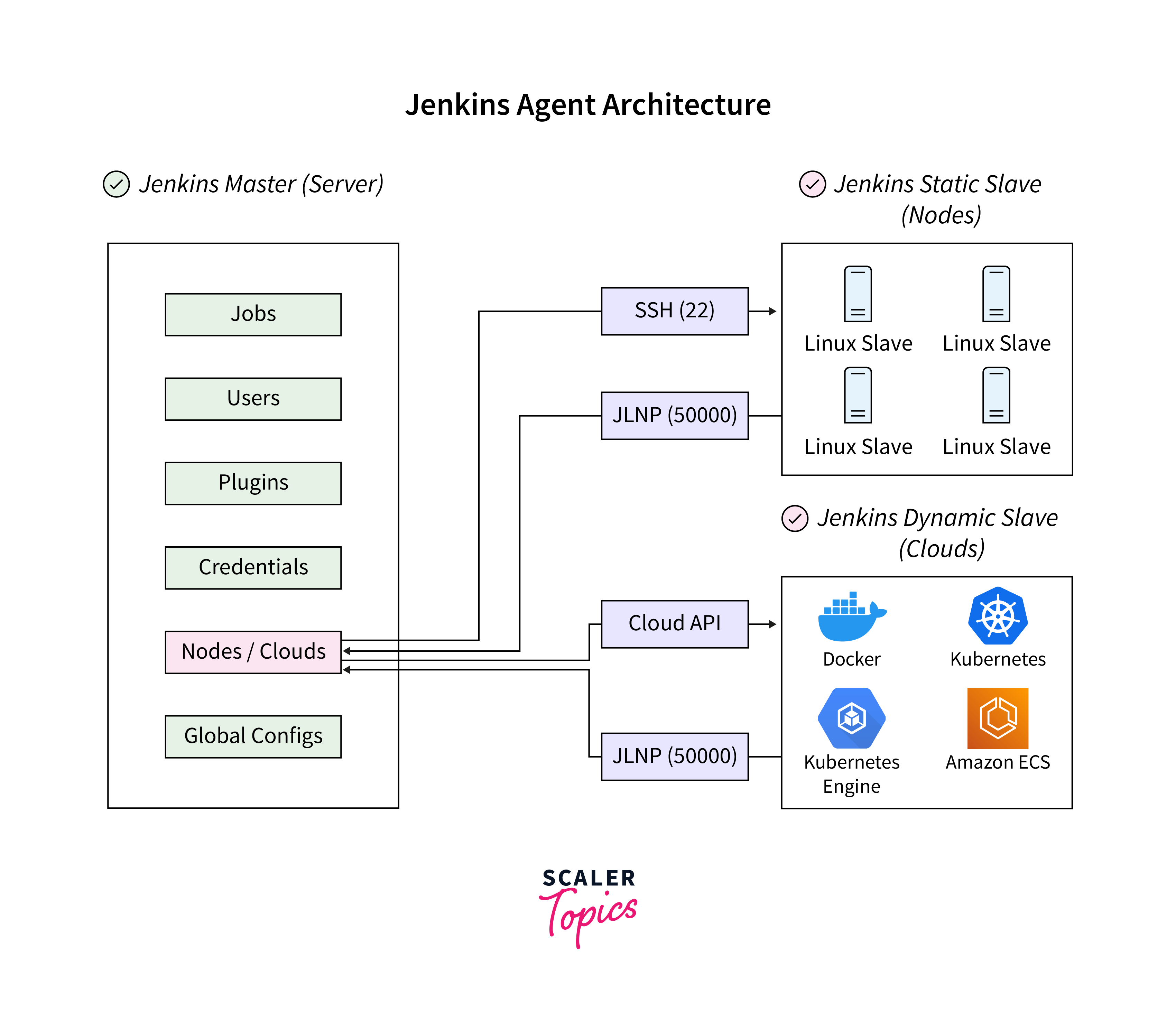
The Jenkins Agent architecture involves a central Jenkins server (Master) that manages and schedules jobs. Agents, connected to the Jenkins central server, handle the actual execution of these jobs. This separation ensures efficient resource utilization and load balancing.
Components of Jenkins Agent Architecture:
- Jenkins Controller: The central controller that manages and coordinates tasks in the Jenkins environment. It is responsible for scheduling jobs, monitoring agents, and distributing workloads to available agents. It also hosts the Jenkins web interface for configuration and job management.
- Jenkins Node (Slave): Independent nodes are responsible for executing tasks delegated by the Jenkins central controller. It Communicates with the Jenkins Controller over a designated channel, typically secured by SSH or JNLP (Java Network Launch Protocol). Jenkins Agents can be configured on different machines, allowing for the distribution of workloads.
- Channel: The channel acts as a communication link between the Jenkins Controller and Jenkins Agents. Secure channels are established using protocols like SSH or JNLP, ensuring encrypted and authenticated communication. Channels enable the exchange of commands, build artefacts, and job status information between the Jenkins Central controller and Jenkins Agent.
- Jenkins Agent Controller Plugin: Formerly known as Jenkins Controller manages the lifecycle of agents, including their registration, job assignment, and de-registration. It orchestrates the communication between multiple agents and ensures tasks are distributed efficiently.
- Build Executor: It is the runtime environment provided by the Jenkins Agent for executing a specific job. It executes build steps, runs scripts, and manages the overall execution of the assigned task. Multiple build executors can run concurrently on a single agent, enabling parallel job execution.
Types of Jenkins Agents
Jenkins supports various types of agents, each designed to cater to specific use cases and deployment scenarios. Understanding the different types of Jenkins Agents allows teams to choose the most suitable model based on their project requirements. Here's an elaboration on the types of Jenkins Agents:
-
Permanent Jenkins Agents:: Permanent agents are the bedrock of stability, meticulously configured on dedicated machines. They maintain a steadfast connection with the Jenkins Master, ensuring a persistent link for job execution.
Use Case: Ideal for projects characterized by a steady workload and specific infrastructure requirements. Permanent agents offer reliability, particularly when a constant, available agent is crucial. -
Cloud Jenkins Agents: Enter the dynamic realm of cloud agents, responding to the ebb and flow of workloads. These agents are conjured on demand, adapting to the evolving requirements of each job.
Use Case: Tailored for environments with unpredictable build demands, cloud agents excel in optimizing resource utilization. They dynamically scale to meet varying workloads, ensuring efficiency. -
Docker/Kubernetes Jenkins Agents: Witness the fusion of Jenkins with cutting-edge containerization technologies – Docker and Kubernetes. Agents take the form of containers, providing an agile and scalable approach to job execution.
Use Case: Crafted for the intricacies of modern microservices architectures and environments embracing container orchestration. Docker/Kubernetes agents are tailored for efficiency in such dynamic landscapes.
With a clear understanding of the types & use cases of Jenkins Agent, teams can decide which one suits the best purpose.
Setting Up Permanent Jenkins Agents
Setting up permanent Jenkins agents involves configuring and connecting agents that remain consistently available for job execution. These agents are manually configured on dedicated machines and maintain a persistent connection with the Jenkins Master. Here's a step-by-step guide on how to set up permanent Jenkins agents:
Prerequisites:
- Central Jenkins Server (Jenkins Master) Configuration: Ensure that Jenkins is installed and configured on the master server. Have administrative access to Jenkins to configure agent settings.
- Agent Machine: Prepare a machine that will serve as the permanent agent. Ensure the machine has the necessary software and tools for executing the jobs.
Steps to Set Up Permanent Jenkins Agents:
- Access Jenkins Master: Log in to the Jenkins web interface using your administrator credentials.
- Navigate to Manage Jenkins: Click on "Manage Jenkins" in the left-hand menu.
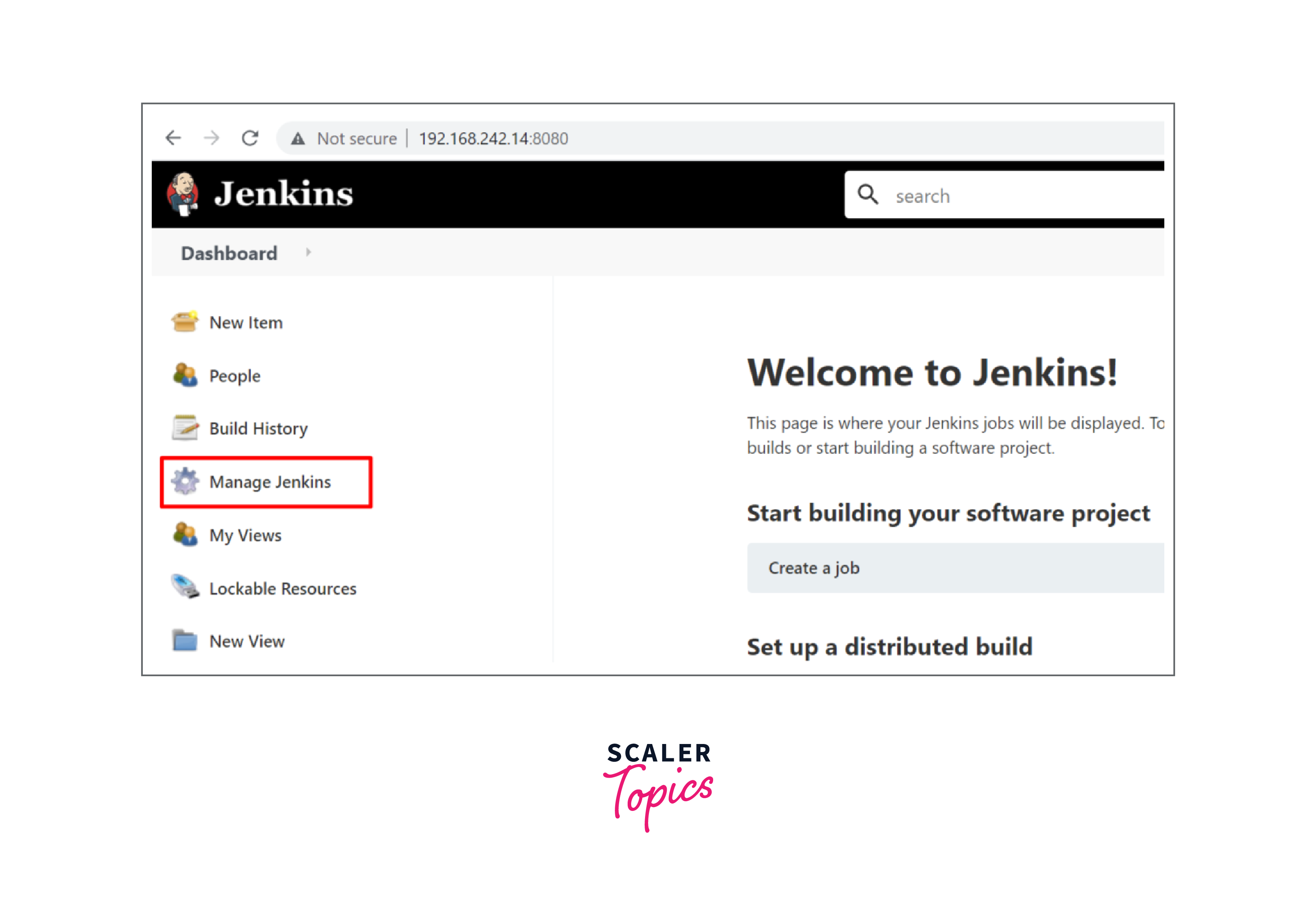
- Access Manage Nodes and Clouds: Click on "Manage Nodes and Clouds" to view the list of existing nodes.
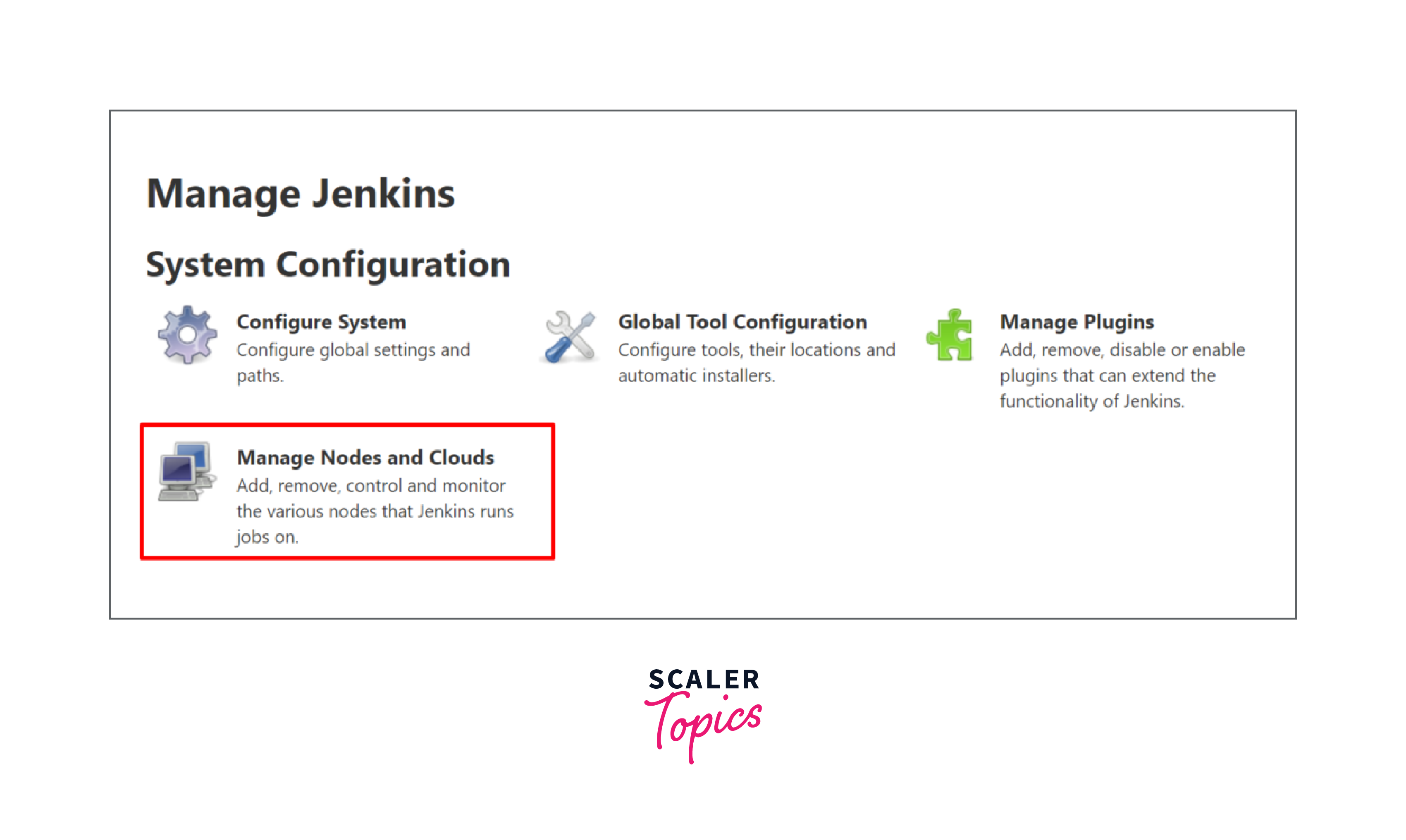
- Add a New Node: Click on "New Node" or "New Agent" to start the process of adding a new permanent agent.
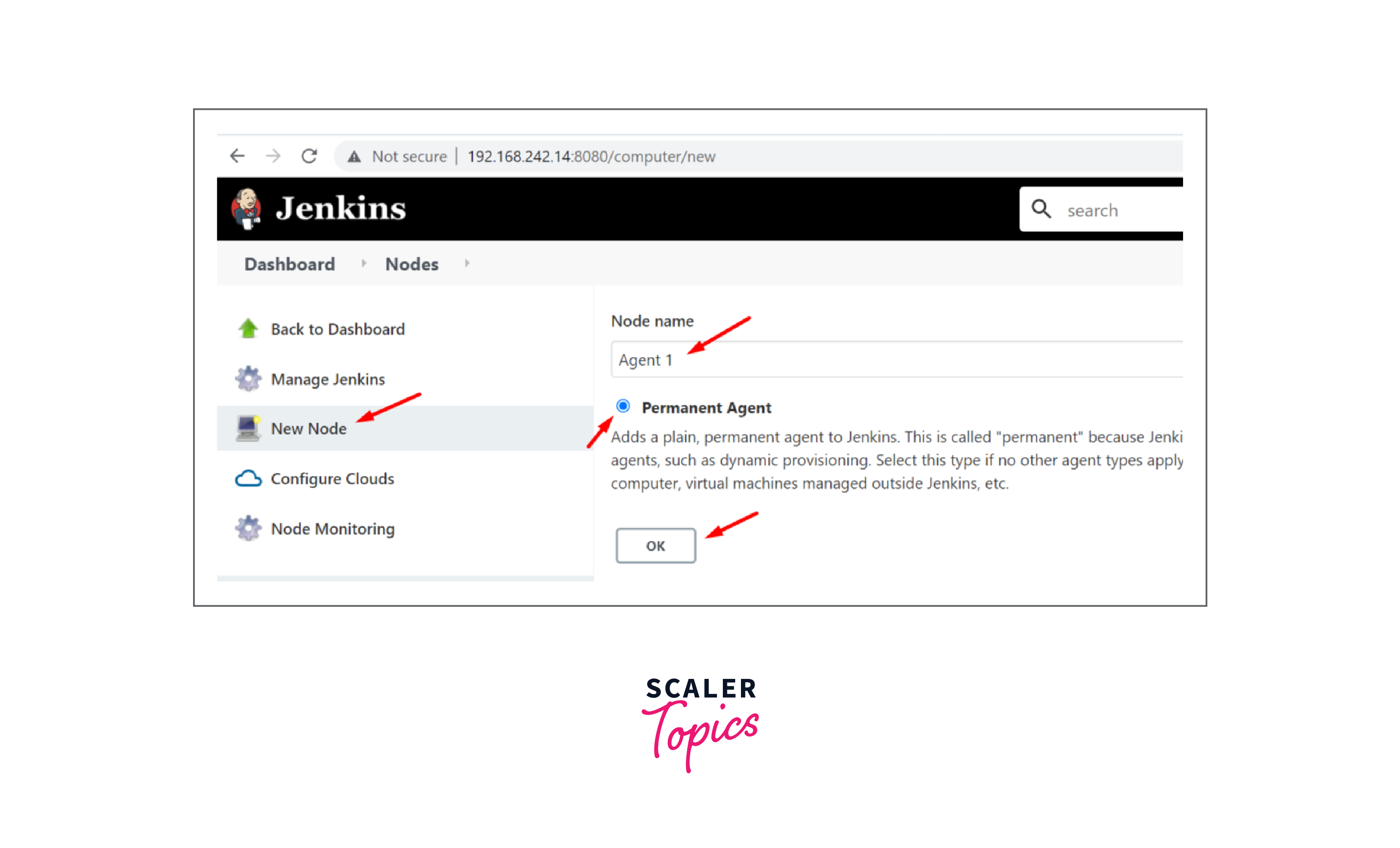
- Configure Node Details: Provide a name for the agent (e.g., Permanent-Agent-1). Choose the option "Permanent Agent".
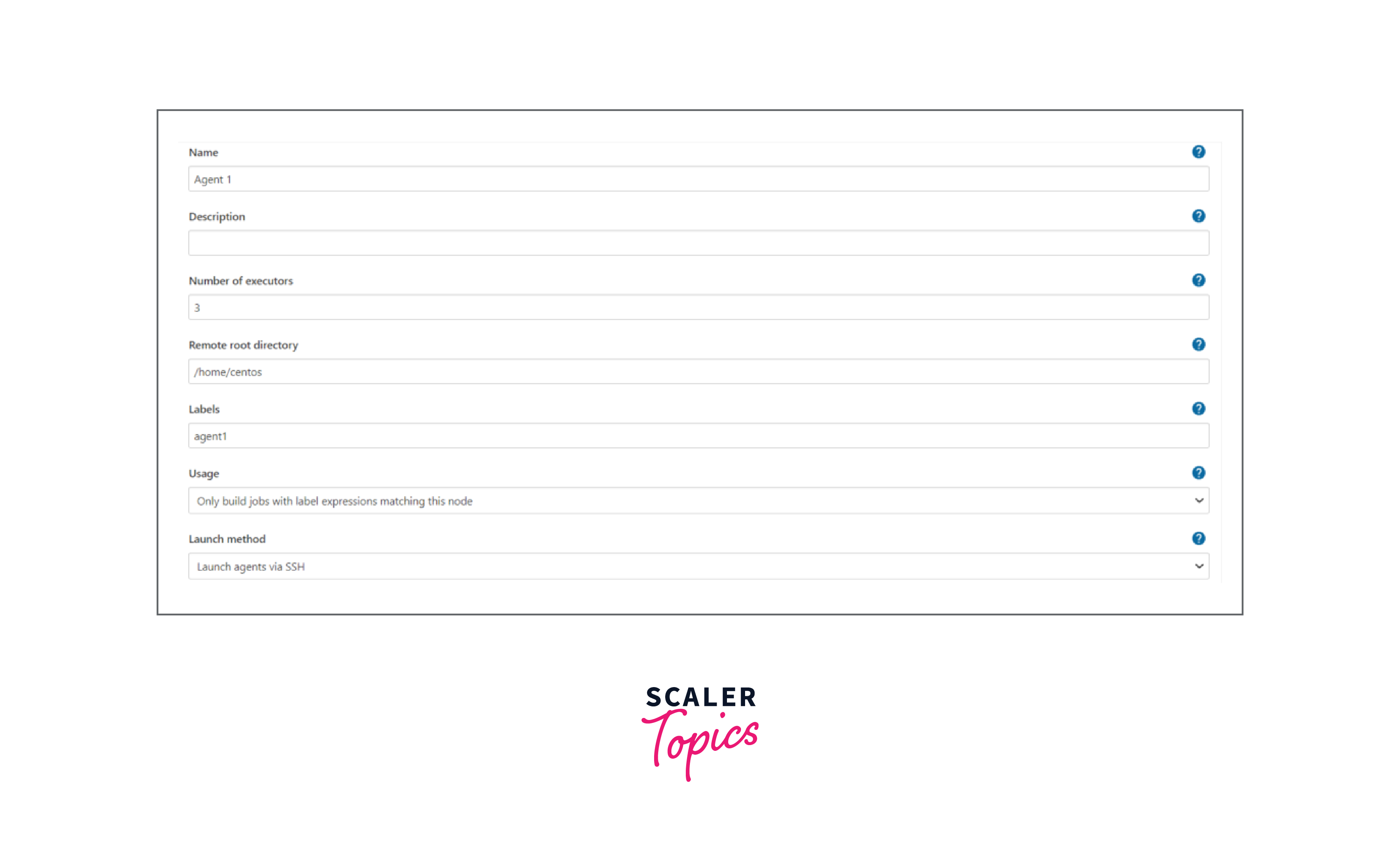
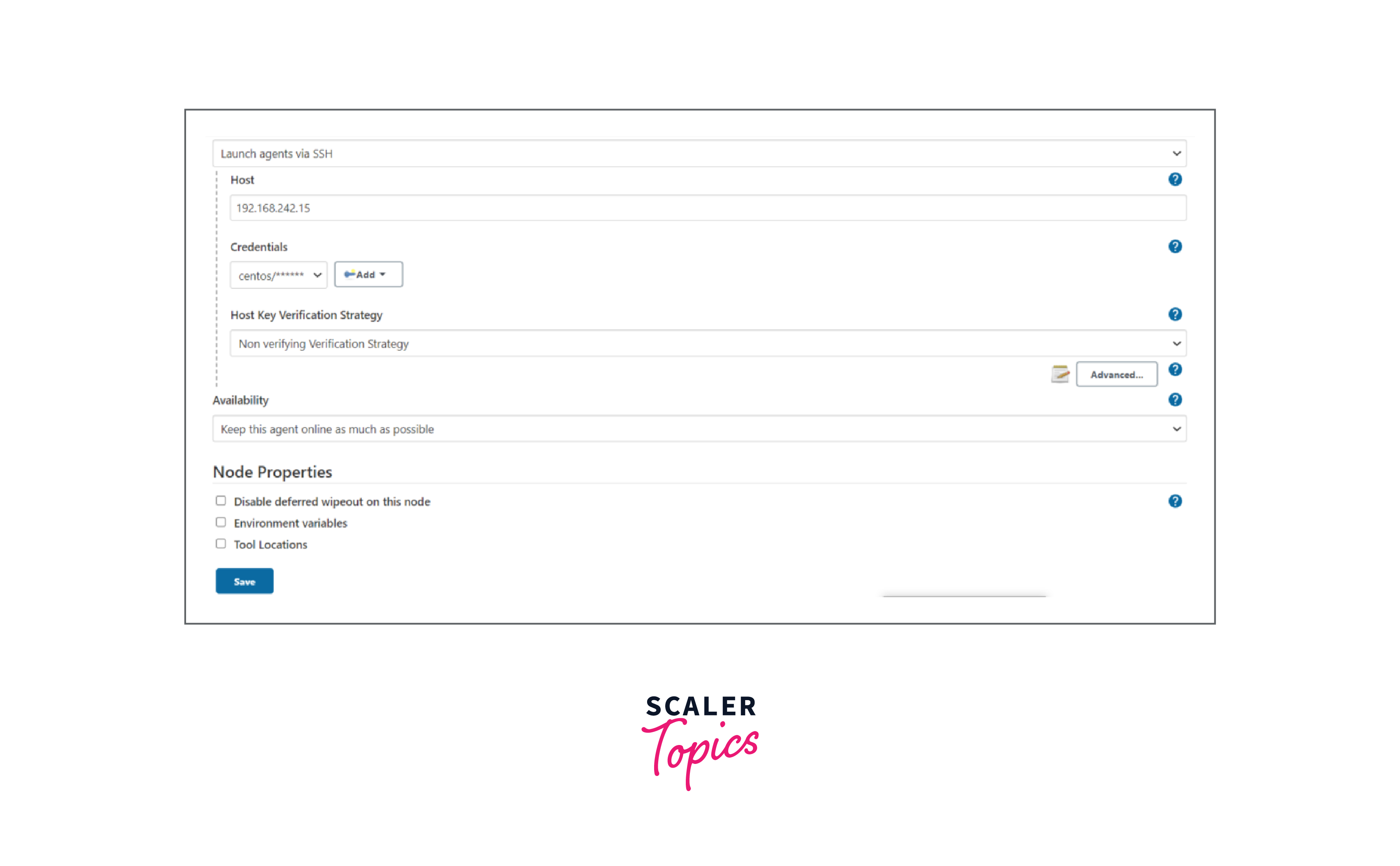
- Configure Launch Method: If using SSH, provide the connection details (host, username, private key) for connecting to the agent machine. For Windows agents, you might choose to launch via Java Web Start (JNLP).
- Configure Usage: Specify the maximum number of concurrent builds the agent can handle. Set labels to categorize and identify the agent for job assignments.
- Save Configuration: Click "Save" or "Save and Apply" to save the agent configuration.
- Launch Agent: Select the agent from the list and click "Launch Agent" to initiate the connection.
- Verify Connection: Monitor the Jenkins interface to ensure that the agent successfully connects.
- Check Agent Status: Go back to "Manage Nodes and Clouds" to verify that the permanent agent is listed and marked as online.
Setting up permanent Jenkins agents provides stability and reliability, making them suitable for projects with consistent workloads and specific infrastructure requirements. Regularly monitor and maintain these agents to ensure seamless operation within your CI/CD pipeline.
Dynamic Scalability with Cloud Agents
Dynamic scalability refers to the ability of a system or infrastructure to adapt and adjust its resources based on the current workload or demand. In the context of Cloud Agents, this often involves dynamically increasing or decreasing the number of Build Agents, to enhance varying levels of activity. The goal is to ensure optimal performance, resource utilization, and responsiveness to changes in demand, without unnecessary over-provisioning or underutilization. Following are some of the steps on what you could do to implement it in an organizational scenario.
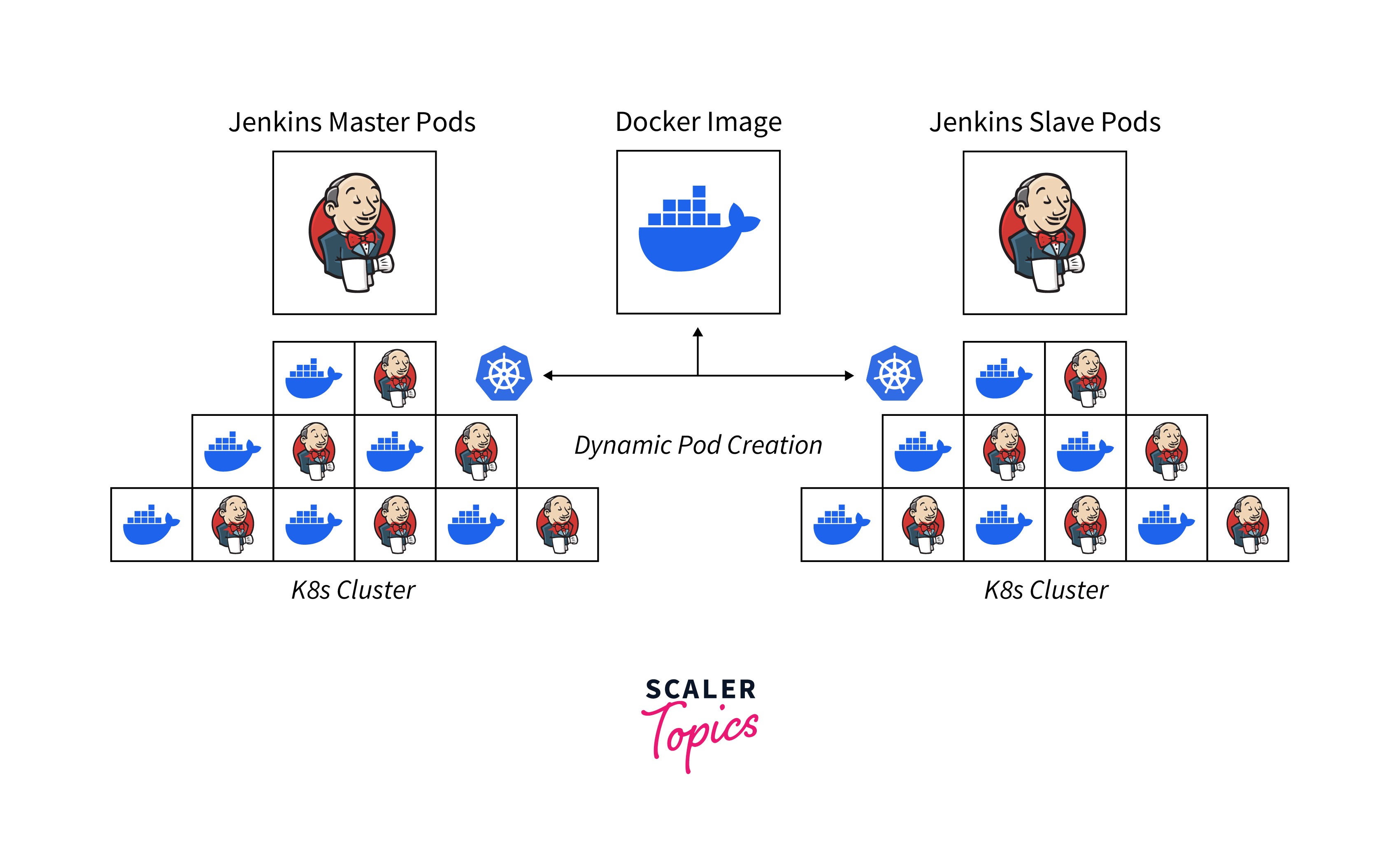
- Cloud Provider Integration: Select a cloud provider (e.g., AWS, Azure, Google Cloud) that aligns with your organization's infrastructure and requirements. Integrate the corresponding cloud provider plugin in Jenkins to enable seamless communication and resource management.
- Cloud Agent Templates: Create templates that specify the configurations for the cloud agents, including machine types, operating systems, software installations, and other parameters. Attach labels to these templates to categorize agents based on capabilities, environments, or project-specific requirements.
- On-Demand Provisioning: Enable on-demand provisioning, allowing Jenkins to dynamically create new agents when a job is triggered. Configure the cloud plugin to scale the number of agents up or down based on the workload.
- Resource Limits and Auto-Scaling Policies: Set resource limits for each cloud agent to avoid overconsumption of resources. Implement auto-scaling policies to adjust the number of agents dynamically in response to changes in demand.
- Monitoring and Alerts: Utilize cloud provider tools or Jenkins monitoring plugins to track cloud agent metrics, such as CPU usage, memory consumption, and job execution times. Establish alerts for abnormal behaviour or performance degradation, ensuring proactive issue resolution.
- Idle Agent Handling: Configure idle agent timeouts to automatically de-provision agents when they are not actively running jobs. Prevents unnecessary consumption of cloud resources and contributes to cost savings.
- Documentation and Training: Maintain detailed documentation on cloud agent configurations and dynamic scalability setups. Ensure that the development and operations teams are well-trained in managing and understanding the dynamic scalability features.
Implementing dynamic scalability with cloud agents in Jenkins not only enhances the efficiency of the CI/CD pipeline but also provides cost-effective solutions for organizations.
Utilizing Docker/Kubernetes Agents
Utilizing Docker and Kubernetes agents in Jenkins provides a flexible and scalable approach to building and deploying applications. By containerizing Jenkins agents, teams can create reproducible build environments, improve resource utilization, and streamline the integration of CI/CD workflows. Here's a guide on how to effectively utilize Docker and Kubernetes agents in Jenkins:
- Install Docker/Kubernetes Plugin: Install the Docker and Kubernetes plugins in Jenkins. These plugins enable Jenkins to interact with Docker and Kubernetes to provision and manage build agents.
- Configure Docker Agents: Set up Docker on the machines where Jenkins agents will run. Create Docker images containing the necessary build tools and dependencies for your projects. Configure Jenkins to use these Docker images as agents for specific jobs.
- Configure Kubernetes Agents: Set up a Kubernetes cluster where Jenkins agents will be orchestrated. Define Kubernetes pod templates specifying the Docker image, resource requirements, and other configurations for Jenkins agents. Configure Jenkins to use these Kubernetes pod templates for job execution.
- Labeling and Node Selection: Assign labels to Docker or Kubernetes agent configurations based on capabilities or requirements. In Jenkins job configurations, use these labels to specify where the job should run.
- Dynamic Agent Provisioning: Enable dynamic provisioning in Kubernetes configurations, allowing Jenkins to dynamically create and scale agents based on workload. For Docker, utilize the Docker Cloud or Docker Swarm configurations in Jenkins to achieve dynamic provisioning.
- Resource Management: Configure resource limits and requests for Docker and Kubernetes agents to ensure proper allocation of CPU and memory. Implement auto-scaling policies in Kubernetes to adjust the number of agents dynamically based on resource needs.
- Documentation and Training: Document Docker and Kubernetes agent configurations thoroughly. Provide training to the team on utilizing Docker and Kubernetes agents effectively within Jenkins.
By integrating Docker and Kubernetes agents into Jenkins, development teams can achieve a more streamlined and scalable CI/CD pipeline. The containerized approach ensures consistency across different environments, facilitates easy scaling, and enhances resource efficiency. Regularly review and update configurations to adapt to evolving project requirements and advancements in containerization technologies.
Managing Jenkins Agent Nodes
Managing Jenkins agent nodes is crucial for maintaining an efficient and scalable CI/CD infrastructure. Here's a comprehensive guide to managing Jenkins agent nodes:
- Node Configuration and Labels: Ensure accurate and up-to-date configurations for each node, including connection details, labels, and resource allocations. Labels help categorize nodes based on their capabilities.
- Node Health Checks: Implement regular health checks on nodes to identify and address potential issues proactively. This ensures that nodes are responsive and in good condition.
- Security Measures: Prioritize security by ensuring secure communication between the Jenkins master and agent nodes. Regularly update agent software and configurations to address security vulnerabilities.
- Dynamic Scalability: For cloud nodes, define auto-scaling strategies to dynamically adjust the number of agents based on workload. This optimizes resource utilization and responsiveness to changing demands.
- Documentation and Training: Maintain comprehensive documentation on node configurations and management procedures. Provide training to the team on effective ways to manage Jenkins agent nodes.
These considerations ensure the reliability, security, and scalability of your CI/CD infrastructure, allowing for a smoother development and deployment process. Regularly reviewing and optimizing these aspects contributes to a more efficient Jenkins pipeline.
Jenkins Agent Security
Ensuring the security of Jenkins agents is crucial for maintaining the integrity of your CI/CD pipeline and protecting sensitive information. Here are five key points to consider for Jenkins agent security:
- Secure Communication: Configure Jenkins agents to communicate with the Jenkins master over secure, encrypted channels. Use protocols like SSH or JNLP with encryption to prevent eavesdropping on sensitive data.
- Authentication and Authorisation: Implement robust authentication mechanisms for Jenkins agents. Use secure methods like SSH keys or certificates to authenticate agents with the Jenkins master.
- Agent Node Isolation: Run Jenkins agents in isolated environments to prevent interference between different jobs. Use tools like Docker or virtual machines to provide a clean and reproducible environment for each job execution.
- Resource Limits: Implement resource limits for Jenkins agents to prevent them from consuming excessive system resources, mitigating the risk of resource exhaustion attacks.
- Monitoring and Logging: Use monitoring tools to watch 'Jenkins agents' performance and activity. Keep an eye out for any unusual or suspicious behaviour. Set up Jenkins agents to record pertinent actions and events. Create alerting systems for security incidents and centralise logs for analysis.
Implementing these security practices helps fortify the Jenkins agent environment, protecting against potential threats and ensuring the confidentiality, integrity, and availability of your CI/CD processes.
Monitoring and Performance
Monitoring and ensuring optimal performance in Jenkins Agents are critical aspects of maintaining a robust CI/CD environment. Effectively managing these aspects guarantees smooth operation, minimizes downtimes, and enhances the overall efficiency of the development pipeline.
Monitoring Jenkins Agents:
- Resource Utilization Monitoring: Utilize monitoring tools like Prometheus, Grafana, or built-in Jenkins monitoring.
Metrics: Track CPU usage, memory consumption, disk I/O, and network activity on both Jenkins Master and Agents. - Job Execution Metrics: Collecting data to monitor job execution times, success rates, and failures.
Analysis: We can identify trends and bottlenecks to optimize resource allocation. - Build Queue Analysis: Keeping an eye on build queue lengths and waiting times will help when to scale. Scale Dynamically: Adjust the number of Jenkins Agents based on the queue analysis to prevent build bottlenecks.
- Health Checks: Implementing health checks on Jenkins Agents to ensure they are in optimal condition. Alerts: Setting up alerts for abnormal behaviour or performance degradation will help in checking the health of Jenkins Agent & instance on which we are running our Jenkins.
Optimizing Performance in Jenkins Agents:
- Parallel Execution: We can leverage parallel execution on agents with multiple build executors and configure Jenkins jobs to run in parallel for faster builds.
- Agent Node Configuration: To optimize performance we can adjust resource allocation for agents based on job requirements. Isolating using separate agent nodes for different types of jobs will prevent resource contention.
- Agent Health Checks: Implementing regular health checks on agents will help identify and address potential issues proactively.
- Optimized Build Tools: Ensuring that the versions of build tools (e.g., JDK, Maven) on agents are up-to-date and implementing build caching mechanisms will help avoid redundant work and speed up builds.
- Docker/Kubernetes Resource Management: Set resource limits for Docker/Kubernetes agents to prevent resource exhaustion. While dynamic Scaling we can utilize Kubernetes autoscaling to adjust resources dynamically.
Jenkins Pipeline and Agent Integration
Integrating Jenkins pipelines with agents is a fundamental aspect of building scalable and automated CI/CD workflows. Jenkins pipelines allow you to define, automate, and visualize your entire build and deployment process, while agents provide the execution environment for these pipeline stages. Here's a guide on integrating Jenkins pipelines with agents:
- Pipeline Syntax: Start by defining your Jenkins pipeline using the Declarative or Scripted syntax. This is typically done in a Jenkinsfile stored within your version control system.
The agent any directive allows Jenkins to run the pipeline on any available agent.
- Agent Selection: Specify a specific agent or label for the pipeline stages. This is useful when you have specialized agents for certain tasks.
In this example, the pipeline will run on agents labelled with 'docker'.
- Multiple Stages with Different Agents: You can assign different agents to different stages of your pipeline.
Here, the 'Build' stage runs on agents labelled 'docker', the 'Test' stage can run on any available agent, and the 'Deploy' stage runs on agents labelled 'kubernetes'.
- Dynamic Agent Allocation: Utilize the agent none directive to dynamically allocate agents during pipeline execution based on specific conditions or criteria.
- Parallel Execution: Leverage parallel execution to distribute workload across multiple agents concurrently.
Here, the 'Build' and 'Test' stages can run in parallel on different agents.
-
Agent Setup in Jenkins Configuration: Configure agent labels, availability, and other settings in the Jenkins master configuration to match the labels and requirements specified in your pipeline.
-
Node Block for Scripted Pipelines: In scripted pipelines, use the node block to allocate agents.
This is equivalent to the agent { label 'docker' } syntax in declarative pipelines.
By integrating Jenkins pipelines with agents using these techniques, you can create flexible, scalable, and efficient CI/CD workflows. Choose the appropriate agent configurations based on your project requirements and infrastructure setup. Regularly review and optimize your pipeline for better resource utilization and faster builds.
Best Practices for Jenkins Agents
- Documentation: Maintaining comprehensive documentation for Jenkins Agent configurations will be very helpful. It ensures that the setup is well-documented for troubleshooting, onboarding new team members, and managing changes.
- Agent Isolation: Running jobs in isolated environments will help prevent interference between different jobs. It will help avoid conflicts in dependencies and configurations, ensuring build reproducibility.
- Dynamic Scaling: For dynamic scaling we can implement dynamic agent provisioning and de-provisioning based on workload. It ensures optimal resource utilization, scalability, and cost-effectiveness in cloud or containerized environments.
- Monitoring and Metrics: Continuously monitoring Jenkins Agent performance and health will help keep us notified if something goes out of track. Setting up alerts for abnormal behaviour or performance degradation will help.
- Resource Allocation: Allocating resources (CPU, memory) appropriately for each agent node will be beneficial so that Jenkins Agents have sufficient resources to execute jobs efficiently without causing resource contention.
- Backup and Recovery: Establishing a robust backup and recovery strategy for Jenkins Agents and regularly backing up Jenkins configurations, including agent settings will help if something goes wrong and we want to recover. Have a plan for recovering agent configurations in case of failures.
- Regular Updates: Keep Jenkins and agents up-to-date with the latest releases and security patches will help in bug fixes and security patches
Troubleshooting Jenkins Agents
- Review Jenkins Agent & Master Logs: Examine the logs of the Jenkins agents for any error messages or warnings. Logs can provide insights into issues affecting agent connectivity or job execution. Access agent logs directly on the agent machine or through the Jenkins interface.
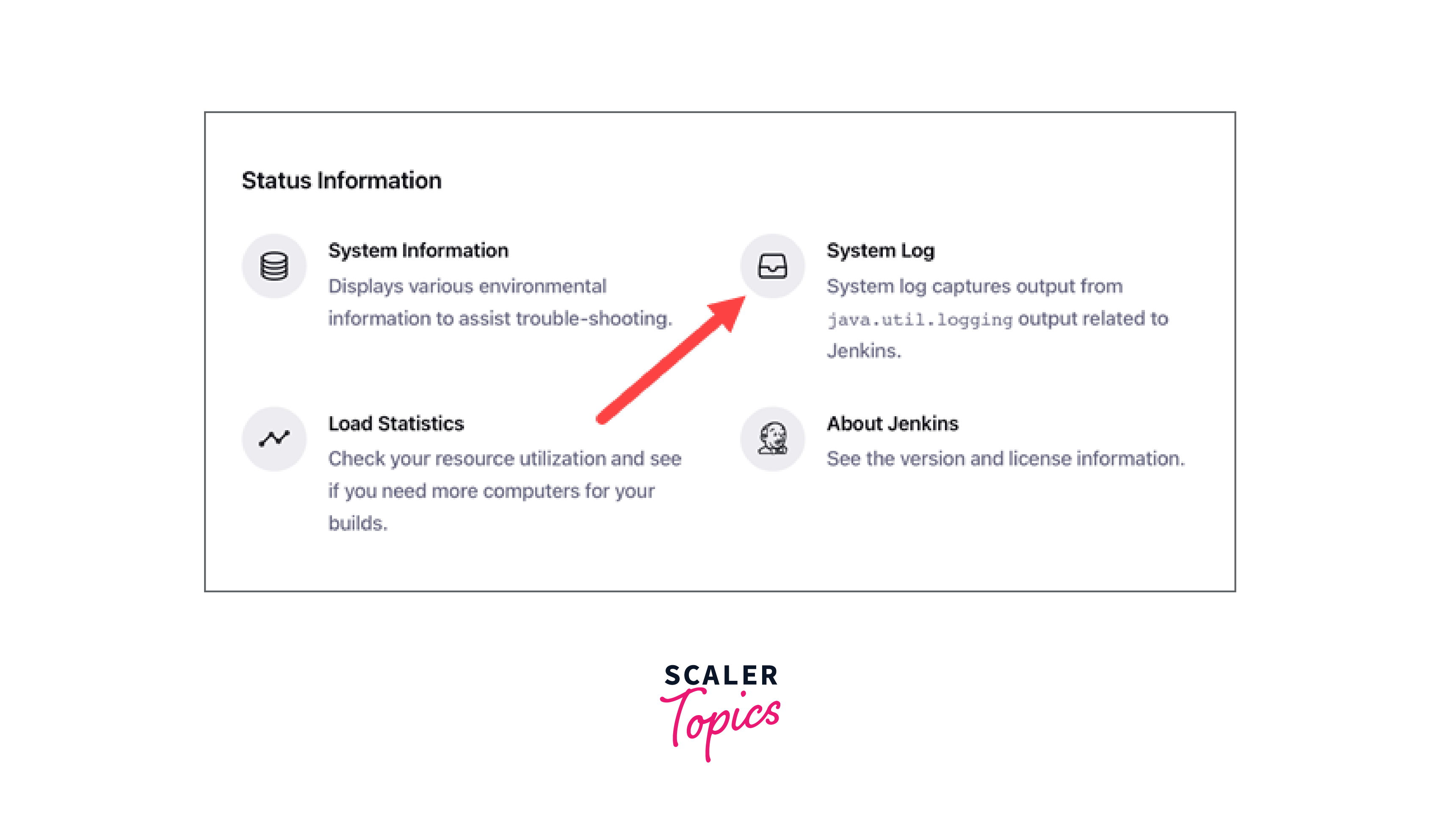
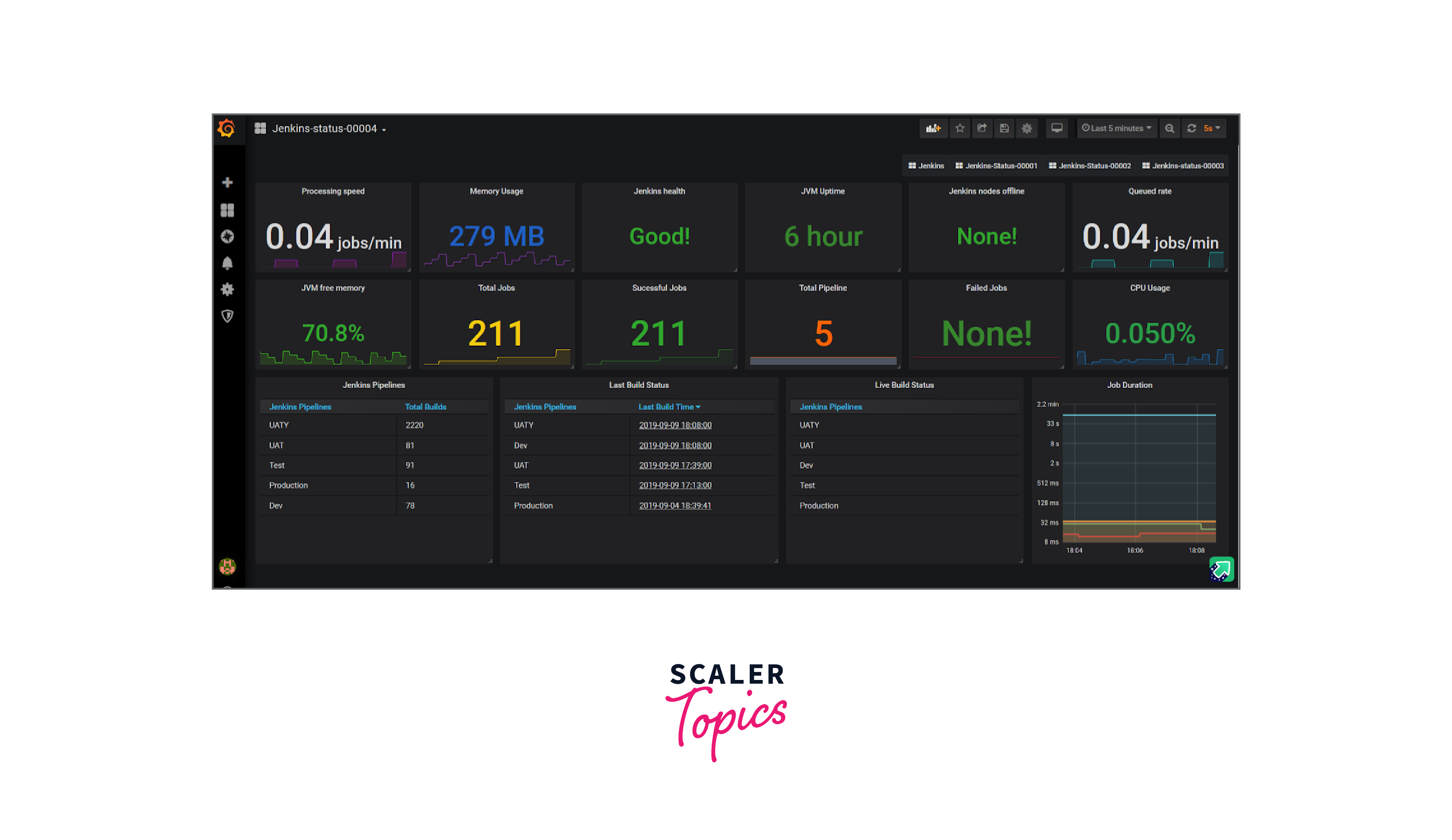
- Resource Constraints: Inspect resource constraints on agents. Ensure that agents have sufficient resources (CPU, memory) to execute jobs. Adjust resource allocations if agents are consistently reaching resource limits. We are using Prometheus & Grafana to monitor our Jenkins you could choose the toolyou wish to use.
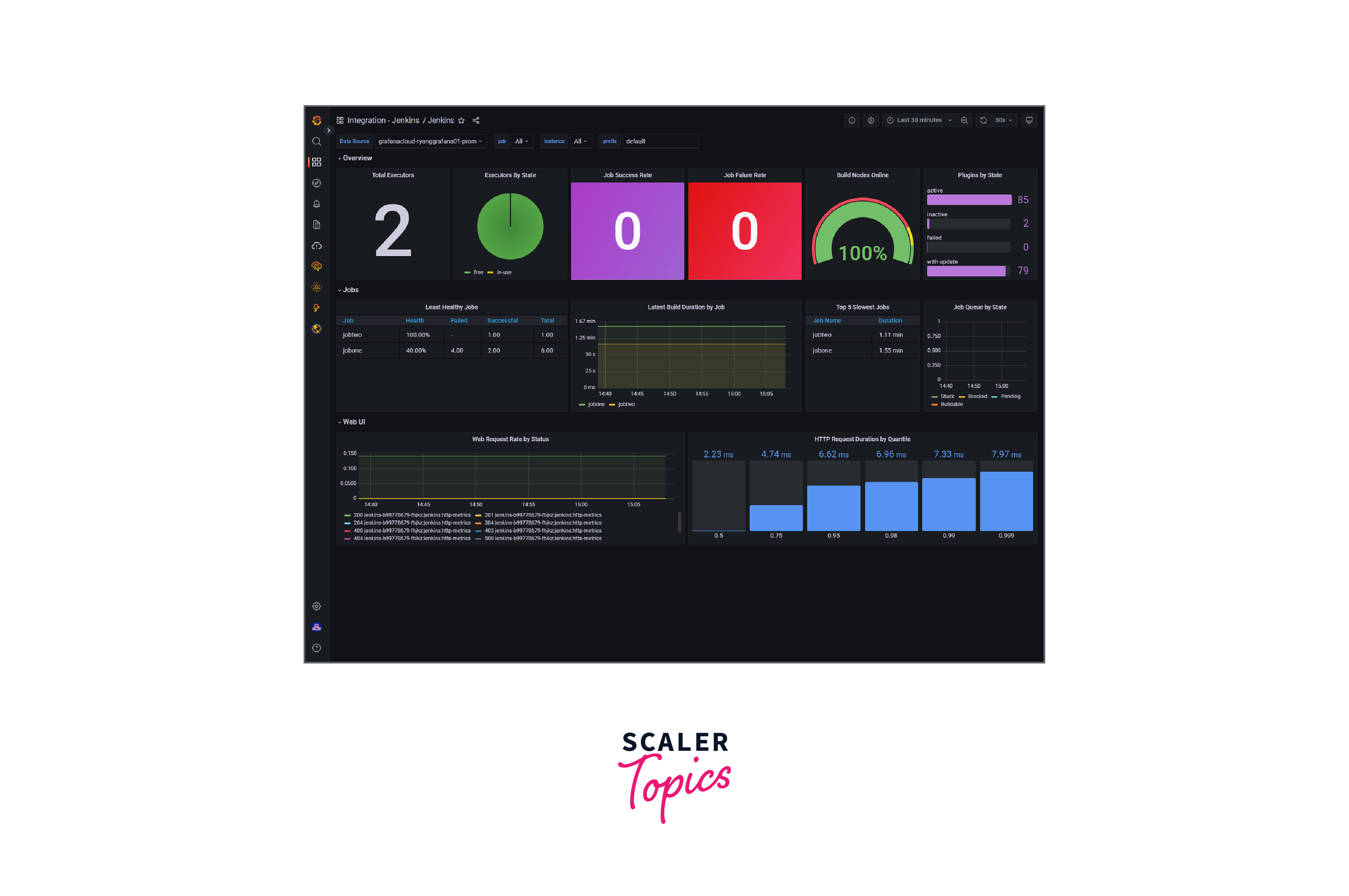
- Update Agent Software: Ensure that agents are running the latest version of the Jenkins agent software. Regularly update agent software to benefit from bug fixes, performance improvements, and security patches.
- Consult Jenkins Community and Documentation: Utilize the Jenkins community forums, mailing lists, or other channels for assistance. Refer to the Jenkins documentation for troubleshooting tips and best practices. Jenkins Community page: https://community.jenkins.io/
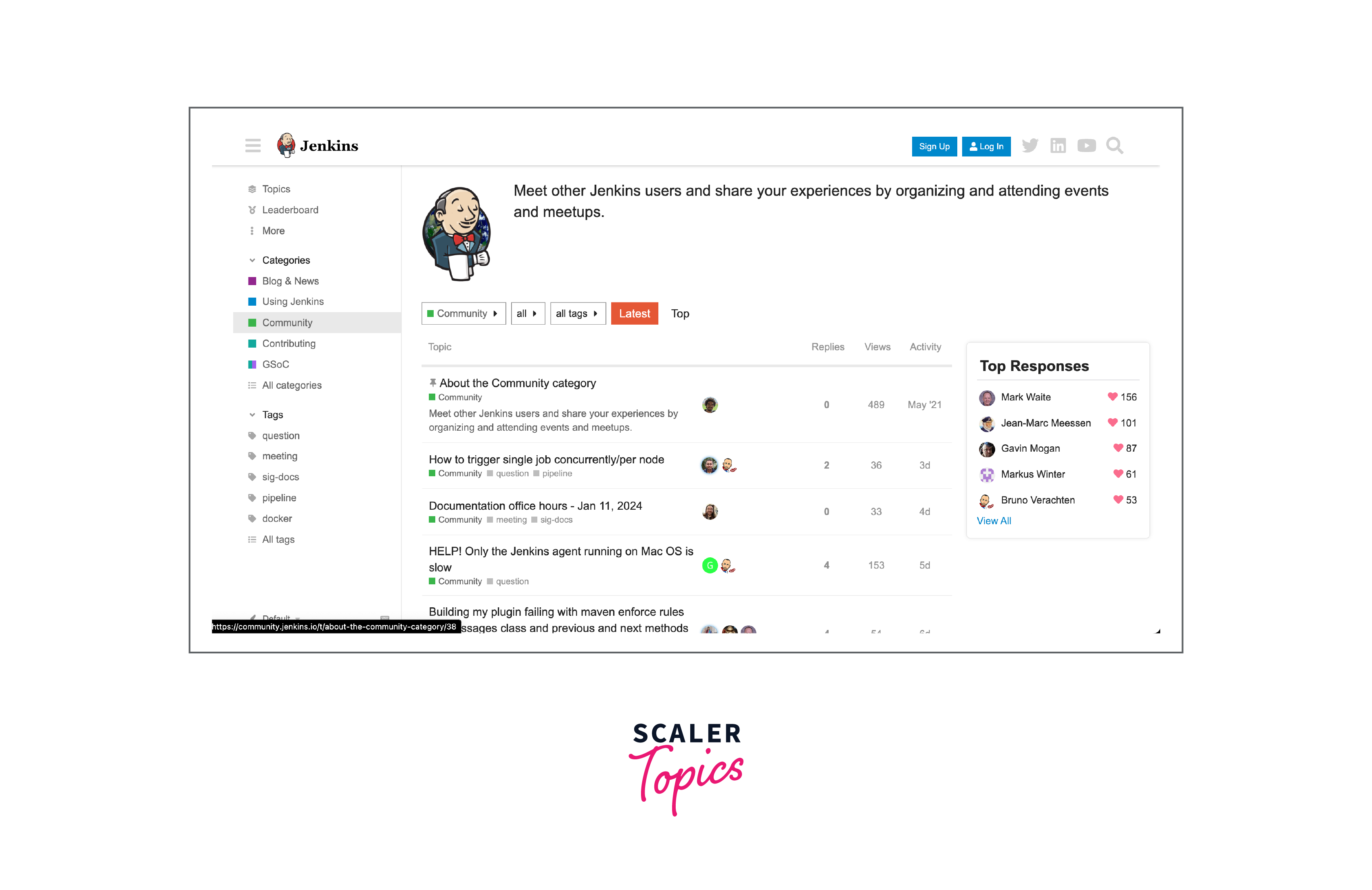
These are some of the common things one can check while troubleshooting, before going in depth. Many other scenarios can occur and cause problems but ensuring the basic setup is working properly will save a lot of time and confusion.
Conclusion
- Agents are independent nodes responsible for executing tasks delegated by the Jenkins Master, promoting parallelism and optimal resource utilization.
- The architecture involves a central Jenkins server (Master) coordinating tasks, while agents handle the actual job execution, ensuring efficiency and load balancing.
- Permanent Agents offer stability for consistent workloads, Cloud Agents dynamically scale based on demand, and Docker/Kubernetes Agents provide a scalable, containerized approach.
- Considerations include accurate configurations, regular health checks, security measures, dynamic scalability, and effective handling of idle agents.
- Emphasize documentation, agent isolation, dynamic scaling, monitoring, resource allocation, and regular updates for efficient and reliable agent management.
